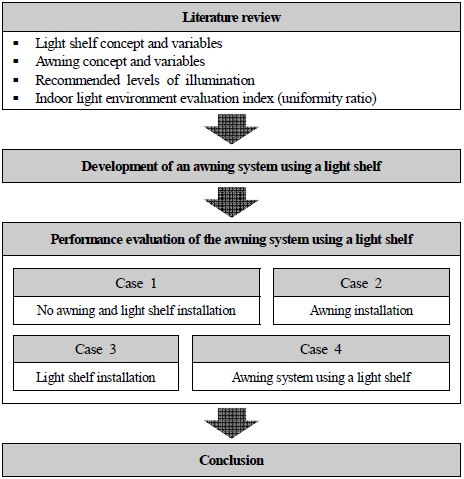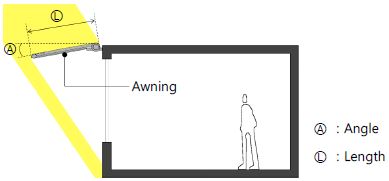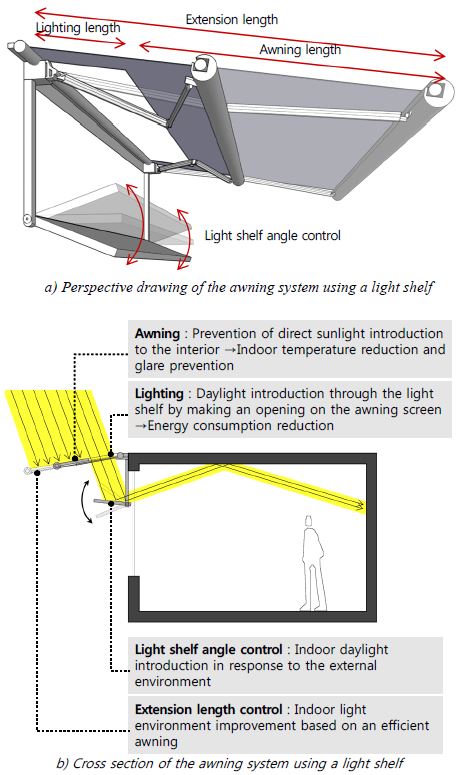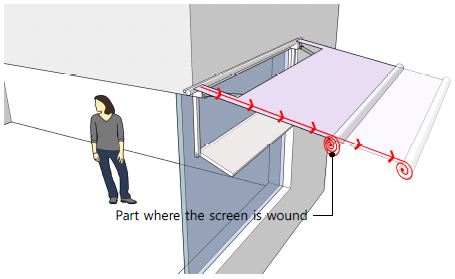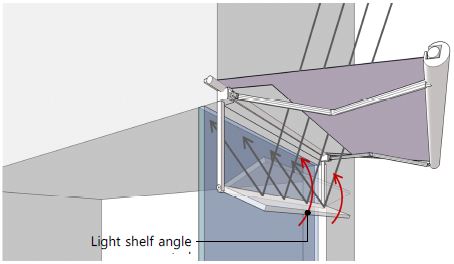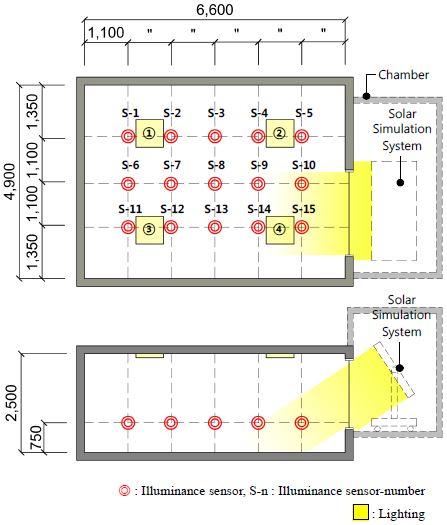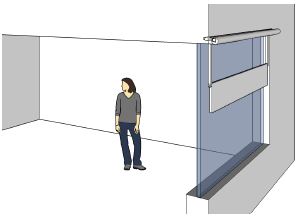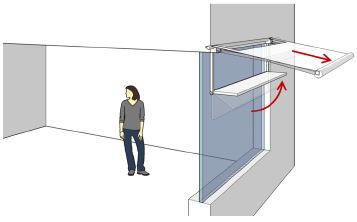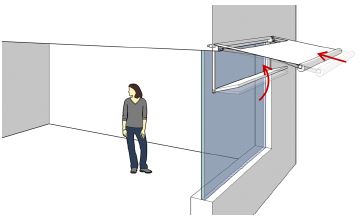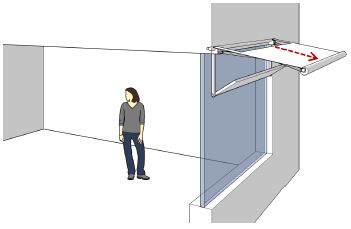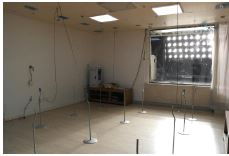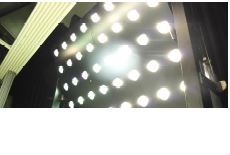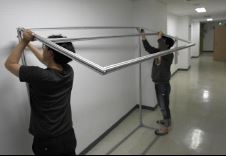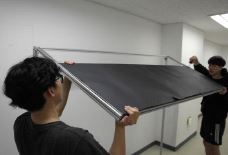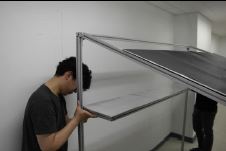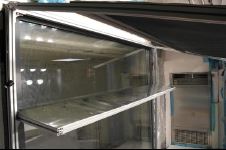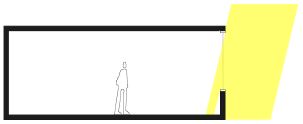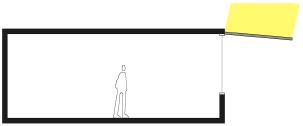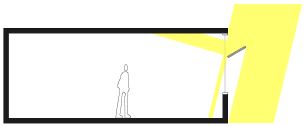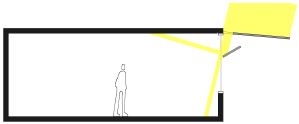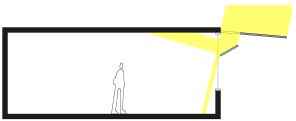
Development of Awning System using Light Shelf : Focusing on the light environment and lighting energy reduction performance improvement -
ⓒCopyright Korea Institute of Ecological Architecture and Environment
Abstract
Various studies have been performed to address the issue of increased energy use by buildings. In particular, research on complex envelopes that combines diverse envelope element techniques is currently in progress in the building sector. The present study aimed to develop an awning system using a light shelf, and to verify its validity through performance evaluation.
In the present study, a testbed was established for the performance evaluation of the awning system using a light shelf, and the uniformity ratio and lighting energy consumption were compared and analyzed relative to those with no awning and light shelf installation (Case 1), awning installation (Case 2), and light shelf installation (Case 3).
1) In the present study, an awning system using a light shelf (Case 4) where an opening is made on the awning screen and natural light can be introduced through the light shelf located at the bottom was developed. 2) The optimum standard for Case 4 obtained through the performance evaluation was a 0.6m lighting length and a 2m extension length at a light shelf angle of 30°. 3) Case 4 with the optimum standard had a 5.5% lower uniformity ratio than Case 2, but had a higher uniformity ratio than Case 1 and Case 3. 4) Case 4 with the optimum standard showed 13.3%, 44.6%, and 0%~8.7% lighting energy reductions compared to Case 1, Case 2, and Case 3, respectively. 5) Based on the above results, Case 4 suggested in the present study was found to be effective for indoor light environment improvement and lighting energy reduction.
Keywords:
Awning, Light-shelf, Performance evaluation, Energy saving, Uniformity factor키워드:
어닝, 광선반, 성능평가, 에너지저감, 균제도1. Introduction
1.1. Background and Purpose of Research
According to energy consumption survey for buildings in 2016 by Korea Environmental Industry & Technology Institute (KEITI), the energy consumption of building sector accounted for about 20% of the total energy consumption, and it is estimated to show an energy increase of about 1.4% per year until 2040 [1]. As a result, interest in energy consumption in the building sector is expected to get higher. Particularly, lighting energy consumption in the building sector is as high as 20% of the total energy consumption of the building sector. Also, as the demand for improving the quality of life increases, the demand for the technologies simultaneously demanding the comfort of indoor space is also increasing. As a part of this research, the development of converged envelope that combines element technology of envelope has been increasing the case of maximizing the comfort of indoor space as well as building energy saving [2].
Awning, which is one of the envelope element technology, is a shading system that is installed on a main entrance or window of building to control light, and is possible to improve the glare and the indoor light environment by primarily shielding the direct light from the outside. However, the installation of awning may reduce the amount of natural light introduced into the room, thereby causing an increase in lighting energy. On the other hand, the light shelf, which is one of the natural light system, is a system that allows the external natural light to flow into the room through reflection, which is advantageous for daylighting energy saving. In this respect, it can be predicted that the proper combination of awning and light shelf can lead to improvement of indoor light environment of existing awning system, as well as lighting energy savings.
This study proposes Light Shelf Built-in Awning System and aims to demonstrate its effectiveness by performing performance evaluation of lighting energy saving and indoor light environment comfort based on test bed.
1.2. Procedures and Scope of Study
This study was proceeded according to the following procedure as shown in <Fig. 1>, to develop Light Shelf Built-in Awning System and evaluate the performance
First, we reviewed the concept and variable of Awning and Light Shelf were, and examined uniformity factor, which is an indicator of indoor proper illumination and indoor light environment for performance evaluation. Second, we proposed Light Shelf Built-in Awning System based on the review. Third, to carry out performance evaluation of Light Shelf Built-in Awning System (Case 4), Awning and Light Shelf not installed (Case 1), Awning installed (Case 2), and Light Shelf installed (Case 3), we conducted the performance evaluation by deriving illumination energy usage and uniformity factor.
However, this study was limited to summer solstice where the efficiency of the solar insulator was highest [3]. In addition, this study was limited the contents of lighting energy increase caused by the installation of Awning, and the contents of indoor heating change and energy saving of heating and cooling equipment were excluded from this study. ‘
2. Concept of Awning and Light Shelf, performance evaluation related index review
2.1. Concept and Variables of Awning
Awning is a shading system that is widely applied to low-rise commercial buildings, and prevents the rise of the room temperature and the glare by blocking the direct light and controlling the amount of natural light that flows into the room, by installing a screen on the main entrance or window of a building. However, Awning is disadvantageous which may cause an increase in lighting energy consumption by reducing the amount of natural light introduced into the room
Awning varies depending on the size of the window or entrance of the building, as shown in <Fig. 2>, but the protrusion length is generally varied from 1.0m to 3.5m based on the specifications of the Awning manufacturer [4]. In addition, the angle of Awning is applied at an inclination angle of about 5 degrees to prevent the rainwater from accumulating due to change of the weather [5].
2.2. Concept and variables of Light Shelf
As shown in <Fig. 3>, Light Shelf is a natural light system that allows outdoor natural light to flow deep into the room through reflection, which makes efficient illumination energy saving possible. In addition, Light Shelf can control the variables such as height, width, angle, and reflectivity to improve lighting performance in response to the external environment such as sun altitude.
2.3. Proper indoor illumination standard
Maintaining the proper illumination of the indoor space is an important factor that maintains the light environment comfort in the indoor space and at the same time satisfies the illumination energy saving. In this study, KS A 3011 was examined as shown in <Table 1>, and after that, 400 lx was set as the lighting control illumination standard for performance evaluation.
2.4. Indoor light environment evaluation index
In this study, the uniformity factor is derived for indoor light environment evaluation. Uniformity factor is an index of degree of uniformity of indoor illumination distribution. As shown in <Table 2>, the uniformity factor is recommended according to the daylight and illumination conditions [6], and in this study, the minimum illumination for the maximum illumination is derived from various methods to derive uniformity factor.
3. Proposal of Light Shelf Built-in Awning System
3.1. Composition of Light Shelf Built-in Awning System
The shape of Light Shelf Built-in Awning System proposed in this study is as shown in <Fig. 4>, and the details are as follows. First, Light Shelf Built-in Awning System is proposed as combined type of Awning and external type Light Shelf, and Awning is located at the upper part of Light Shelf to perform shield function. Awning of Light Shelf Built-in Awning System, however, made a hole for lighting in part of the screen to allow the main beam to flow into Light Shelf even when the screen of Awning is unfolded. As shown in <Fig 5>, Light Shelf Built-in Awning System proposed in this study has a hole for lightening adjacent to the window to enable lighting regardless of the protrusion length of Awning, and unlike the conventional type, this winding portion was positioned at the end of screen. Second, Light Shelf of Light Shelf Built-in Awning System is located at the bottom of the awning to make angle adjustment possible as shown in <Fig 6>.
3.2. Light Shelf Built-in Awning System Control
The control of Light Shelf Built-in Awning System proposed in this study is proposed to be done by the following procedure as shown in <Table 3>.
First, in the absence of occupants, Awning and Light Shelf are kept in a minimum protruding length and a closed form of -90 °, respectively. Second, when the occupant enters the room, the protrusion length of Awning is maximized and Light Shelf makes illumination values of the room collected by controlling the angle in units of 10° from -10° to 30°. The reason why the projection length of the awning is set to the maximum in the initial control step of Light Shelf Built-in Awning System is that it is advantageous to improve the indoor light environment by maximizing the protruding length to increase the awning area. Third, if there is an angle that satisfies the minimum illumination value of 400 lx or more collected according to angle control of Light Shelf when the protrusion length of Awning is maximum, the control of the Light Shelf Built-in Awning System was terminated by restarting at an angle satisfying 400 lx. However, if there is no Light Shelf angle satisfying 400 lx in the control of Light Shelf angle, the projection length of Awning is gradually decreased and the illumination value according to the angle of Light Shelf is collected. If there is extrusion length of Awning and angle of Light Shelf when the minimum illumination of room satisfies 400 lx during this process, the control of Light Shelf Built-in Awning System is terminated, and if the minimum illumination value measured satisfies 400 lx even after the control of Awning extrusion length minimum and Light Shelf angle has ended, the indoor minimum illumination value by protrusion length of Awning and the angle of Light Shelf is restarted to the nearest value of 400 lx, and after that, control indoor lighting.
4. Performance evaluation settings and results
4.1. Performance evaluation environment setting and building
To carry out the performance evaluation of Light Shelf Built-in Awning System, Test bed was built as shown in <Table 4>, and the test bed was 4.9m in width, 2.5m in height, and 6.6m in depth. The size of window attached to Light Shelf Built-in Awning System is 2.2m in width and 1.8m in height, and the size of the window is based on the fact that it is effective for energy saving when the window area ratio is less than 40% as proposed in the window design guidelines of the Ministry of Land, Transport and Maritime Affairs. In this study, the artificial solar irradiation system was installed so that the artificial climate environment could be created outside the test bed for ease of performance evaluation, and the artificial solar irradiation system was able to set the light amount, height and angle of light source. However, the azimuth angle can not be set due to the mechanical characteristics of the artificial solar irradiation system.
As mentioned earlier, this study was limited to the summer solstice as shown in <Table 5>, and the external illumination setting was set at 80,000 lx based on the related studies [7].
The location of interior illumination sensor for performance evaluation was based on the study that proper location for the room average illumination measurement is 4.4m from the lighting window as shown in <Fig. 7>[8], and 15 illumination sensors were arranged at intervals of 1.1 m considering the size of the space. In addition, the height of the illumination sensor was 75 cm from the bottom based on the KS illumination measurement standard [9].
Light Shelf Built-in Awning System proposed in this study was constructed with 30×30 standard profile as shown in <Table 6> for performance evaluation, and manually controlled shape to conduct performance evaluation according to Awning and Light Shelf variables.
4.2. Variables Setting of Awning and Light Shelf
Awning variable for performance evaluation are as shown in <Table 7>, and the protrusion length of Awning is adjusted at intervals of 0.5m by maximum of 2m based on the specification of the Awning manufacturers [10],and the angle of Awning was set to 5° based on the theoretical consideration of Chapter 2. In addition, lighting length and sunscreen length were set for the protrusion length of Awning due to the characteristics of Light Shelf Built-in Awning System proposed in this study, and the lighting length and sunscreen length of this study were referred to as length which light and sunscreen directly among the protrusion length of Awning.
Light Shelf variable for performance evaluation are as shown in <Table 8>, and the external shape width was 0.6m, and the height was set to 1.8m considering the related studies, [11, 12]. Also, the angle of Light Shelf is set dividing by 10° unit in the range of -10° to 30°.
4.3. Performance evaluation method
This study was carried out according to the following procedures for performance evaluation of Light Shelf Built-in Awning System.
First, to carry out the performance evaluation of Light Shelf Built-in Awning System proposed in this study, Awning and Light Shelf not installed, Awning installed, and Light Shelf installed, respectively are set as Case 1, Case 2, Case 3, and uniformity factor and lighting energy consumption was derived and the performance was compared and analyzed. Second, minimum illumination, maximum illumination and uniformity factor are derived based on the indoor illumination distribution measured according to the set case. Third, in this study, illumination dimming control is performed by combining lighting sensors 2, 4, 12, 14 and illumination lighting 1, 2, 3, 4 to calculate illumination lighting energy consumption of each case. The illumination dimming control is performed when the measured illumination value is less than 400 lx., and the illumination dimming control is used to sequentially perform illumination dimming control from the illumination lighting associated with the indoor illumination sensor with the lowest illumination value. However, the lighting control was terminated when the measured values of the illumination sensor in the illumination dimming control satisfy 400 lx. Fourth, the illumination dimming control is performed so that the values of the illumination sensors associated with the lighting satisfy 400 lx, and energy saving performance evaluation was conducted by calculating the power consumption according to the illumination dimming control satisfying 400 lx. However, the lighting energy consumption reflected 1 hour for setting conditions.
4.4. Performance evaluation result
In this study, the performance evaluation of the Light Shelf Built-in Awning System (Case 4) was carried out, and the performance analysis results of the uniformity factor and lighting energy saving for the Awning and Light Shelf not installed (Case 1), Awning installed (Case 2), Light Shelf installed (Case 3), are as follows
First, the performance evaluation of the Light Shelf Built-in Awning System (Case 4) is as shown in <Table 11>, and the analysis contents are as follows. The increase of protrusion length and the screen length of Awning of Light Shelf Built-in Awning System(Case 4) increases the indoor uniformity factor and the lighting energy use, and the increase of lighting length of Awning increases the amount of natural light that flows into Light Shelf, which is effective for lighting energy saving but the indoor uniformity factor is lowered. In addition, the increase of Light Shelf angle of the Light Shelf Built-in Awning System (Case 4) is suitable for improving the lighting energy and uniformity factor by flowing external natural light deep inside the room. The proper specification of the Light Shelf Built-in Awning System (Case 4) considering this uniformity factor and lighting energy saving is the angle of 30° of lighting shelf built-in with an extension length of 2m and lighting length of 0.6m
Second, Uniformity factor derived from case and variable set in this study does not satisfy the recommended 0.1 value for daylighting as shown in <Table 9> and <Table 11>. However, the results analyzed in terms of the higher the uniformity factor, the better the improvement of the light environment, are as follows. Proper standard-based Light Shelf Built-in Awning System (Case 4) can improve uniformity factors by 16.4% ~ 28.8% and 30.1% respectively in the case of Awning and Light Shelf not installed (Case 1) and Light Shelf installed (Case 3), but uniformity factor is 5.5% lower than in the case of Awning installed (Case 2) with a protrusion length of 2m. This is because, as shown in <Table 10>, awning is not perfect in preparation for Light Shelf angle of 30° of Light Shelf Built-in Awning System(Case 4)
Third, The lighting energy usage of the Light Shelf Built-in Awning System (Case 4) can be reduced at 13.3%, 44.6% and 0% to 8.7%, respectively in the case of Awning and Light Shelf not installed (Case 1), Awning installed Case 2) and Light Shelf installed (Case 3) as shown in <Table 8>and <Table 9>.
Fourth, Light Shelf Built-in Awning System proposed in this study can achieve indoor uniformity factor and lighting energy saving by combining existing Awning and Light Shelf. However, the indoor uniformity factor by the Light Shelf Built-in Awning System (Case 4) tends to decrease due to the reduction of the awning area in the case of Awning installed Case 2) but is significant showing effective improvement in the case of Awning and Light Shelf not installed (Case 1), Light Shelf installed (Case 3).
5. Conclusion
The purpose of this study is to establish basic data in related field by developing Light Shelf Built-in Awning System that combines Light Shelf and Awning for improvement of indoor light environment and building energy saving, and carrying out performance evaluation. The conclusion is as follows.
First, this study proposed an integrated type Awning System with built-in Light Shelf, and it makes sunscreen and lighting possible simultaneously by flowing natural light with the light shelf installed at the lower part of the Awning by making a hole in the awning screen.
Second, the proper specification of the Light Shelf Built-in Awning System (Case 4) for improving lighting energy saving and indoor uniformity factor is angle of 30° of Light Shelf built-in with protrusion length of 2m and lighting length of 0.6m.
Third, Light Shelf Built-in Awning System (Case 4) by derived appropriate standard showed uniformity factor 5.5% lower in the case of Awning installed Case 2), but can improve uniformity factor in the case of Awning and Light Shelf not installed (Case 1), Light Shelf installed (Case 3), so it is analyzed effectively.
Fourth, the lighting energy usage of Light Shelf Built-in Awning System (Case 4) by derived appropriate standard can be reduced at 13.3%, 44.6%, and 0% to 8.7%, respectively in the case of Awning and Light Shelf not installed(Case 1), Awning installed(Case 2) and Light Shelf installed(Case 3), so it is analyzed effectively.
Fifth, putting together the above contents, Light Shelf Built-in Awning System(Case 4) proposed in this study makes both lighting energy saving, which is advantage of Awning and light environment improvement, which is advantage of Light Shelf possible, so it is analyzed effectively.
This study proposed a new concept of converged envelope by combining Light Shelf and Awning, which were existing envelope element technology, and proved its validity by proceeding with performance evaluation accordingly, so it is analyzed effectively. However, the fact that the performance evaluation was conducted based on the artificial environment and the research was conducted only for the summer solstice is as a limitation of this study, and it is necessary to continue various researches to improve it. In addition, future studies for detailed control of Light Shelf Built-in Awning System should be followed.
Acknowledgments
This work was supported by the National Research Foundation of Korea Grant funded by the Korean Government (NRF-2017R1D1A1B03029732)
References
- KEITI, International Energy Outlook 2016, p8, (2016).
- KETEP, the Technology of Energy and Environment Corresponding and Converged envelope & Glazing/Ventilation System, (2010).
- Park, Byoung-Chul, Kim, Yu-Sin, Jeong, Kun-Young, Choi, An-Seop, Lee, Jung-Ho, An Fundamental Study on the Interactive System for Daylight Response Dimming System and Indoor Shading Systems, Proceeding of Annual Conference of the Architectural Institute of Korea Planning and Design, Vol.27(No.1), p992, (2007, Oct).
- Somfy, Installation standard and Product overview
- Design Gyeonggi, Gyeonggi-do standard type street funiture design, p62, (2016).
- Lim, Mann-Taek, Architectural Environmental Planning, Bomundang, p319-320, (2013).
-
Kwon, Wunhyeon, Lee, Heangwoo, Seo, Janghoo, Kim, Yongseong, A Study on Light Shelf System Performance Evaluation Applying User Awareness and Dimming Control in Housing, Journal of the architectural institute of Korea planning & design, Vol.30(No.2), p290, (2014, Feb).
[https://doi.org/10.5659/jaik_pd.2014.30.2.285]

- Jung, Bongkeun, Choi, Anseop, An Experimental Study of the Optimum Spatial Characteristics and Location of Photosensor for Daylight Responsive Dimming Systems, Journal of the Korean institute of illuminating and electrical installation Engineers, Vol.17(No.5), p10, (2003, Sep).
- Korean Standards Service Network, Recommended levels of illumination, KS A 3011, (1998, Jul).
-
www.sunwings.co.kr, www.sunwings.co.kr // (Sunwings, General-type foldable awning standard. www.sunwings.co.kr, , accessed May 2, 2017)
(Sunwings, General-type foldable awning standard, www.sunwings.co.kr accessed May 2, 2017. -
Jeon, Gangmin, Lee, Heangwoo, Seo, Janghoo, Kim, Yongseong, Performance Evaluation of Light-Shelf based on Light Enviorment and Air Conditioner Enviorment, KIEAE Journal, Vol.16(No.5), p50, (2016).
[https://doi.org/10.12813/kieae.2016.16.5.047]

- ho, Dong-Woo, Yun, Gyeong, Kim, Kang-Soo, A Study on Visual Environment Evaluation of Residential Space Using the Radiance Program, Journal of the architectural institute of Korea planning & design, Vol.27(No.2), (2011).
